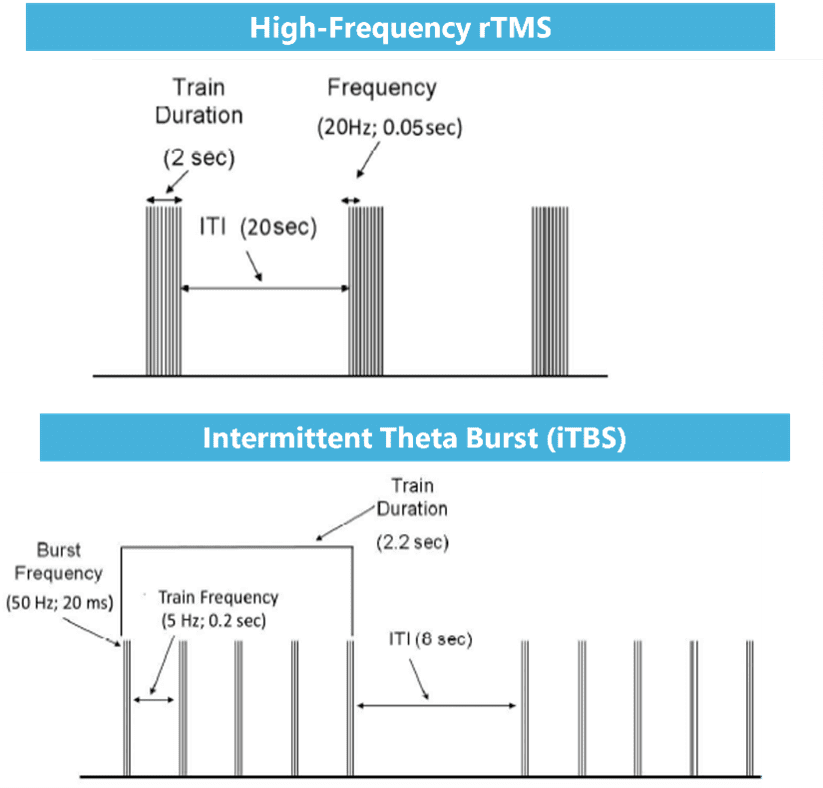Intermittent Theta Burst Stimulation (iTBS) is a newer treatment protocol of Deep Transcranial Magnetic Stimulation (Deep TMS™) that has been FDA-cleared for the treatment of depression. How is the iTBS treatment protocol different from the standard Deep TMS protocol and who might benefit from it? Read on to find out.
Intermittent Theta Burst Stimulation (iTBS) treatment protocol offers patients another effective treatment option. iTBS is a clinically proven, noninvasive in-office brain stimulation procedure that uses electromagnetic fields to activate neural networks in the brain to improve symptoms of depression.
The difference between standard Deep TMS and iTBS protocols is the speed of the electromagnetic pulses. iTBS uses a three-minute protocol for major depressive disorder that involves intermixing of high and low frequencies: bursts of three pulses delivered at 50Hz with the bursts delivered at 5Hz. Ten bursts are delivered every two seconds, for a total of 30 pulses. With 20 trains per session, that equates to 600 pulses per session.
This is in contrast to the standard Deep TMS protocol, which uses our standard high-frequency 20-minute protocol at 18Hz.
The main differentiator for patients is the shorter length of a treatment session. Some patients find the three-minute iTBS protocol easier to fit into their daily schedules. The overall course of treatment is the same for both protocols.

Clinical studies demonstrate the safety and efficacy of the iTBS treatment protocol.
In one study, 146 subjects received either the standard Deep TMS protocol or the three-minute iTBS protocol. Subjects in both groups demonstrated a statistically and clinically meaningful reduction in depression scores, and the results met the equivalence criteria needed for FDA clearance of the shorter treatment. In addition, six abstracts have been published on the use of BrainsWay TBS for treatment of depression.
Read more about clinical studies.
The iTBS protocol holds a number of benefits for patients battling depression. These include:
A key advantage of the theta burst stimulation process is the shorter length of its sessions compared to traditional TMS and standard Deep TMS protocols. Some traditional TMS sessions last up to 40 minutes and standard Deep TMS sessions usually last about 20 minutes. iTBS offers a three-minute protocol, making it much easier to incorporate it into the patient’s routine.
Over time, iTBS for depression has been shown to effectively reduce the appearance and severity of depression symptoms. Its combination of efficacy and tolerability awarded it an FDA clearance status, which highlighted its benefits for patients facing this condition.
As opposed to traditional forms of TMS, both standard Deep TMS and iTBS rely on a helmet, instead of a handheld device. This specialized helmet – which contains BrainsWay’s patented H-Coil — allows Deep TMS to reach wider areas of the brain, and to stimulate deeper areas of the brain directly increasing the treatment’s efficacy. The use of a helmet also prevents any targeting issues that may arise with traditional TMS systems, which may miss a sought-after brain structure due to the use of a handheld device and individual differences in each patient’s brain structure.
Like the standard Deep TMS treatment protocol, iTBS does not cause any significant or long-lasting, side effects. This makes iTBS particularly appropriate for patients wary of possible adverse side effects of other forms of treatment, such as electroconvulsive therapy (ECT) or antidepressant medication.
iTBS does not require the use of anesthesia, nor does it require a lengthy recovery period. This allows patients to incorporate it into their daily routines, without having to block off large portions of their schedules. This is particularly important since the treatment spans four-to-five weeks and is often followed by maintenance sessions.
As a noninvasive treatment, patients are able to combine iTBS with other forms of depression treatment like antidepressants. In fact, undergoing the iTBS treatment protocol while taking antidepressants can enhance the treatment plan’s overall efficacy, thereby delivering better results when compared to a standalone treatment course.